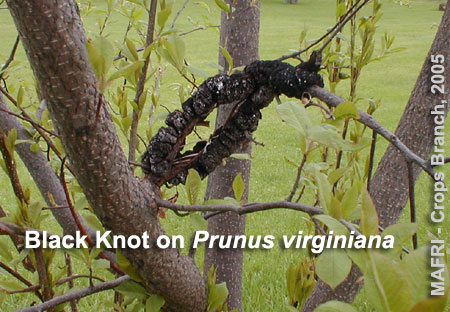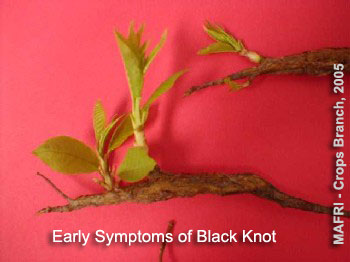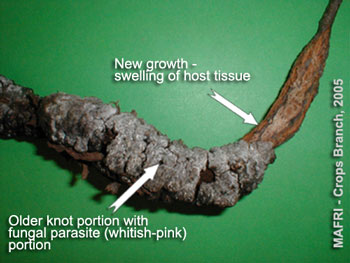Black Knot of Prunus: What are those Black Lumps on my Trees?
Perhaps one of the easiest diseases to recognize, Black Knot of Prunus (cherry, chokecherry, plums and prunes), is becoming such a common sight on many trees in both urban and rural areas of Manitoba, it may be dismissed as a curiosity of little consequence.
In fact, those lumps (galls) are the signs of a fungus (Apiosporina morbosum) which is feeding on the tree and disfiguring it (See Figure 1). While the tree will continue to grow, left untreated, the symptoms will continue to appear. The end result will be a highly stressed, highly distorted and unattractive tree. If galls are allowed to enlarge, branches and even the trunk could become girdled.
One has to be quite observant to see the symptoms during the first season of infection. The galls represent infections that have occurred as much as 20 months earlier. Symptoms often are not observed until the winter of the second season. The initial symptoms can appear as tiny galls on the branches or even merely as swellings of the shoot tissue, giving the shoot a cork like appearance (See Figures 2 and 3). After the winter and into the second season, as summer approaches, the knots develop rapidly changing from a spongy olive green mass to the hardened "charcoal-like" gall. The foliage of the tree at this time can be extensive and these symptoms can be masked by the leaves during the summer.

Figure 1. Black knot gall on Prunus virginiana tree; note charcoal-like appearance of gall
Knots can continue to develop for years. After approximately two years, the older portions of the knot die and may be parasitized by another fungus which gives the knot a white to pinkish tinge. While the blackened swelling may no longer be a threat to infections of healthy tissue, the fungus can still continue to grow. The margins can continue to advance each year. Fungal thread (known as mycelium) inside the plant can also give rise to new galls some distance from the original knot. Allowing major limbs to remain infected with the fungus means that problems will develop later.
The fungus is spread by wind and splashing rain. Infection often takes place during wet periods as short as 6 hours at 21°C but can occur at lower temperatures with longer periods of moisture. The young green shoots and wounded tissues are the most susceptible to infection by the spores (known as ascospores) of the fungus.
This disease is a difficult one to deal with, but as with any disease, the sooner management practices are put into place the better. The strategy should be to avoid problems before they start and remove all sources of potential disease. Ignoring the problem is a good way to ensure that the pathogen will continue to spread, and infected trees continue to develop new symptoms. The more knots you have on the tree and greater the length of time a tree has been neglected, the greater the effort needed to deal with black knot will be.
Even before you decide to plant a Prunus species, get information as to what the level of resistance is in a variety. This is as important to consider as any characteristic of the plant. If you are going to plant a species of Prunus, find out if the tree you are interested in is susceptible to black knot. Often the tart cherries (Prunus cerasus, such as Evans Cherry) show good resistance to black knot. See Table 1 for a list of susceptible Prunus species that can be grown in Manitoba.

Figure 2. Early symptoms of black knot observed shortly after leaf emergence in the spring
Whether you are starting your own cherry orchard, or if you are planting a tree in your own yard, or if you are a commercial nursery producer, consider the area in which you intend to place your trees. Areas with large populations of wild cherries with extensive black knot should be avoided. If there are problems with black knot on trees nearby both on ornamental trees, and wild varieties, consider removing any volunteer or wild cherry trees within 200 meters (this may not be possible if you are in a residential area, it may be preferable to consider planting something else).
Scouting for disease symptoms and looking at Prunus trees on a regular basis is the minimum that should be done. If knots are found, they should be removed. The best time to remove them is during winter. Pruning out infected wood in late winter or early spring, prior to the release of spores in the spring, is ideal. While it may be cumbersome at times, pruning tools should be disinfected between each cut with 10% bleach solution. The cuts should be made at least 15 to 20 cm below the knot even though the tissue appears healthy, the fungus does grow through the branch, under the bark. Even though the knots have been removed, they should be burned, buried, or removed from the area, as they still present a disease risk. Do not leave them near the tree.
Ideally knots should be removed well before they become large growths. However, in the case of larger knots that are on the main scaffold limbs (ie knots that have been present for several seasons), it may be possible to chisel out the knot, without removing the entire limb or the entire tree. Removal of tissue at least 10 cm away from the knot may get rid of the knot, neglecting to remove the infected tissue around the gall will only allow the gall to develop again. It should be noted that severely infected trees, will likely require extensive pruning, and may be greatly disfigured after this treatment.
Chemical control is normally only recommended for high value trees and severe infection levels. They need to be applied as protectants, and will be ineffective if pruning is not done. In the early spring when temperatures are above 16°C and just prior to rainfall are the best times to apply a fungicide.

Figure 3. Old black knot gall parasitized by another fungus giving it a pinkish tinge; Swollen host tissue on right is showing early stages of the disease prior to the formation of the hardened black gall.
| Table 1 Species of Prunus that can be grown in Manitoba (Zone 3) that are susceptible to infection by Apiosporina morbosum, the causal agent of black knot | |
| Latin Name | Common Name |
| Prunus americana | American Plum |
| Prunus avium | Mazzard Cherry |
| Prunus armeniaca var. mandshurica | Manchurian Apricot |
| Prunus besseyi | Western Sandcherry |
| Prunus maacki | Amur Chokecherry |
| Prunus padus | European Bird Cherry |
| Prunus pennsylvanica | Pin Cherry, Wild Red Cherry |
| Prunus serotina | Black Cherry |
| Prunus tomentosa | Manchu Cherry |
| Prunus virginiana | Common Chokecherry, Schubert Cherry |

